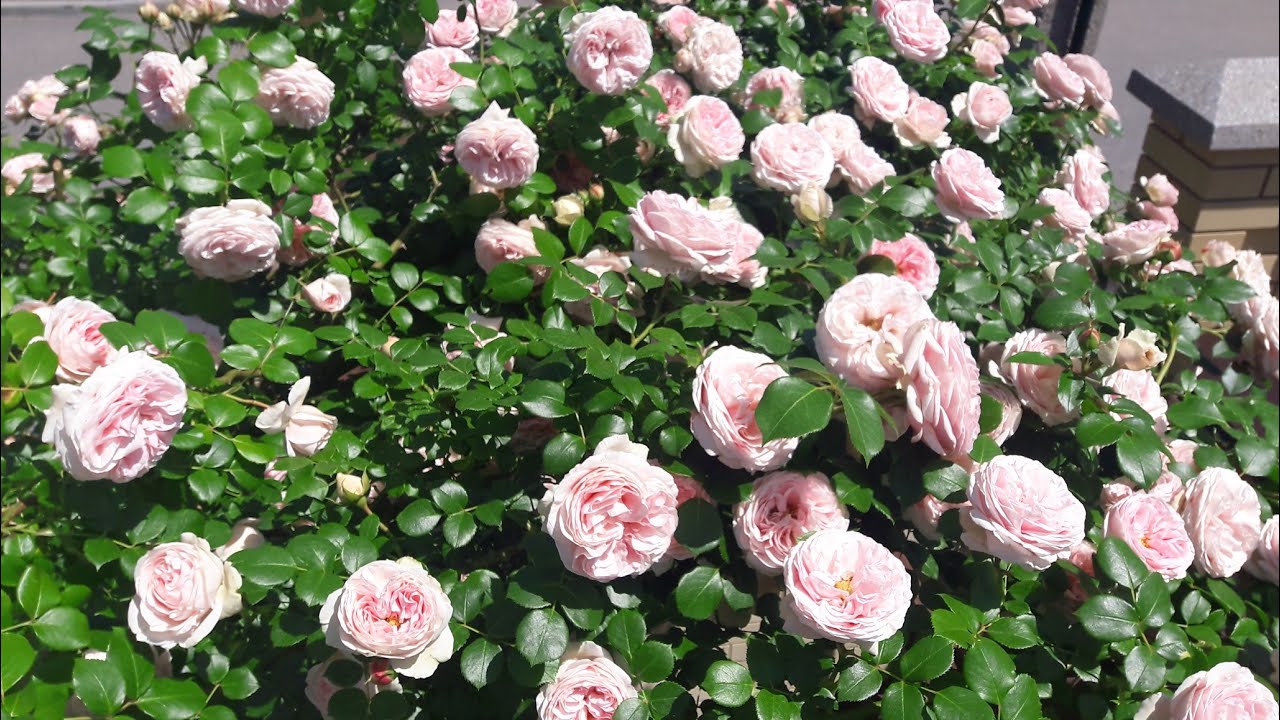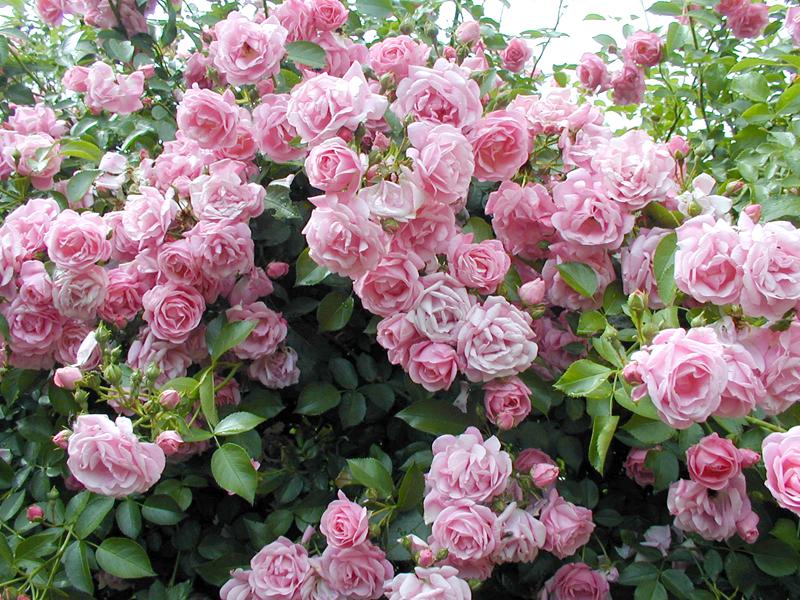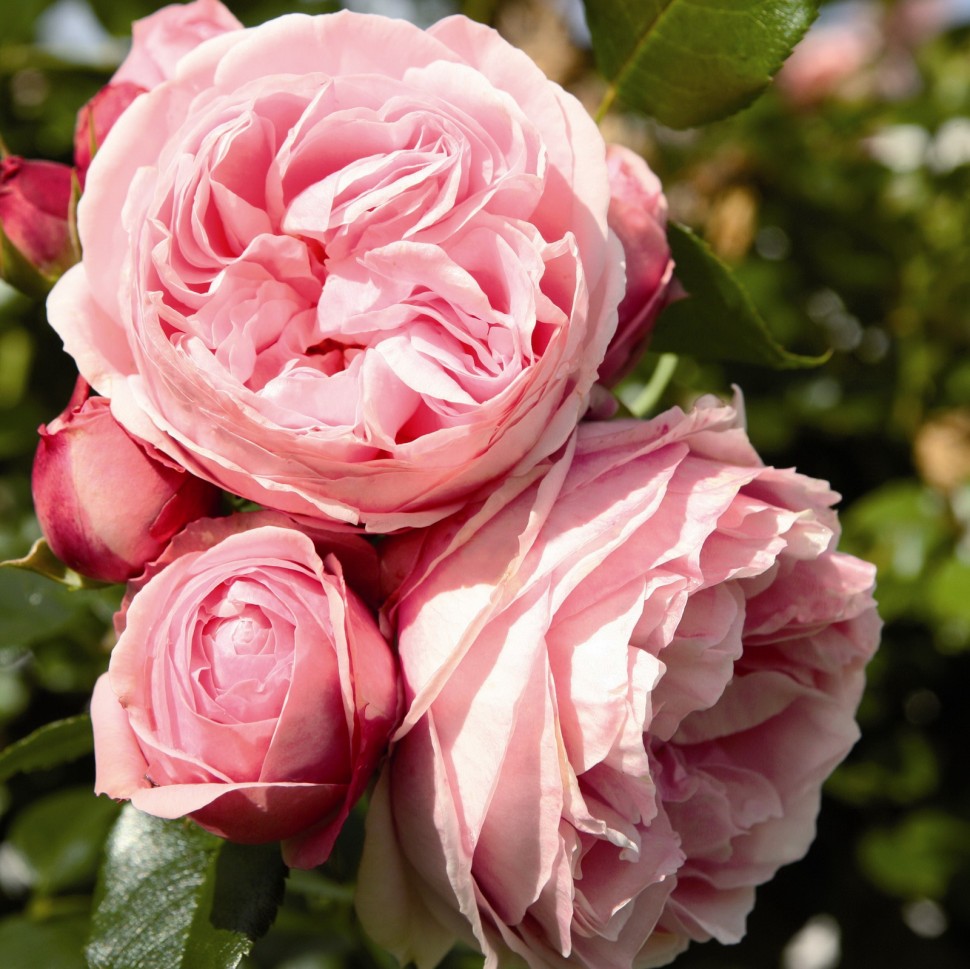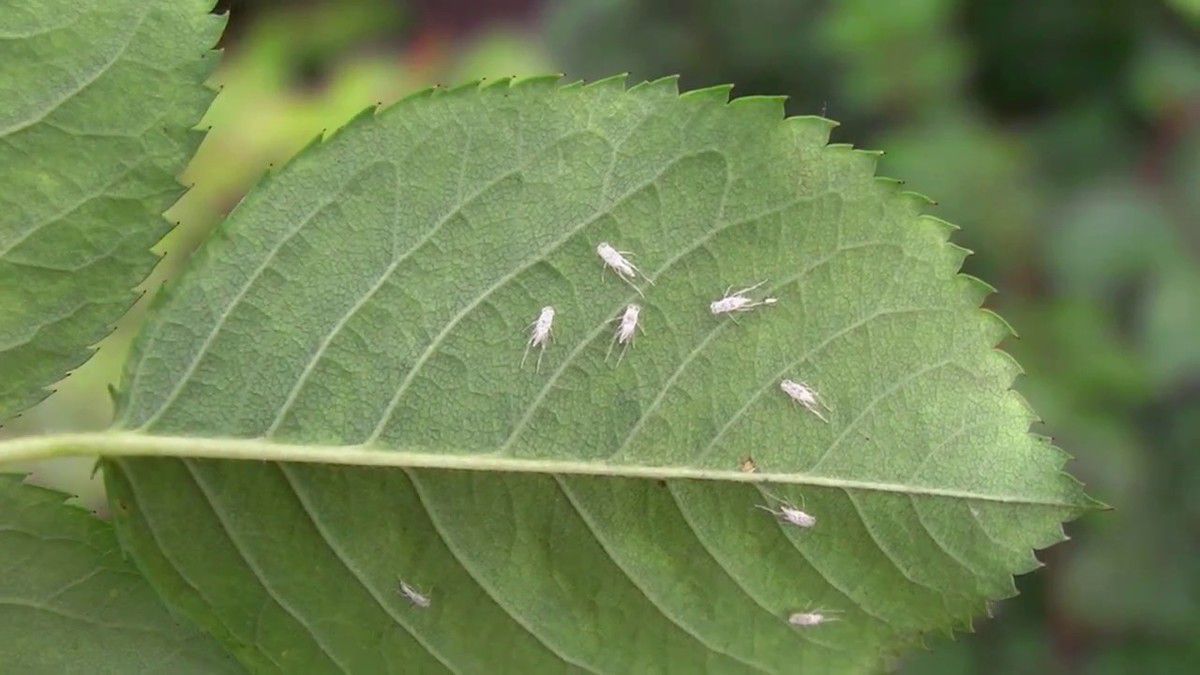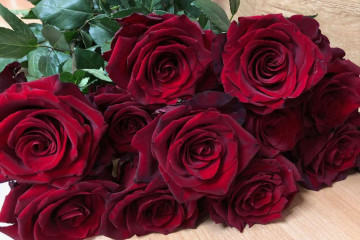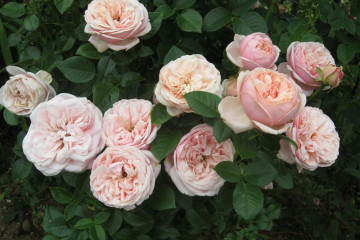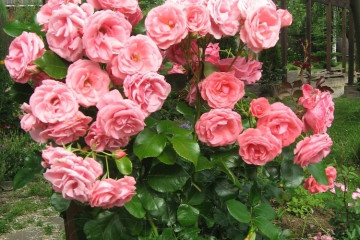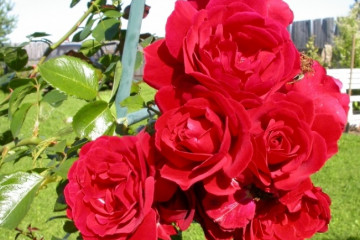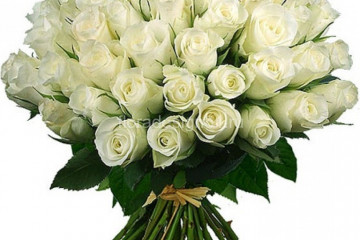Rose Jardina (Giardina)
Content:
- Brief description, characteristic
- Advantages and disadvantages of the variety
- Use in landscape design
- Growing a flower: how to plant it in open ground
- Plant care
- Top dressing and soil quality
- Pruning and replanting
- Features of wintering a flower
- Care during and after flowering
- What to do if it does not bloom; possible reasons
- Flower propagation
- Diseases, pests and ways to control them
Rose Jardina (Giardina, rose Jardine) refers to climbing varieties (in rare cases, the name is pronounced - Giardina). The flower was grown by a florist from Germany in 2008. Rose is highly resistant to sunlight. The opened bud does not fade under the sun during the flowering period.
Brief description, characteristic
The flower bushes can reach a height of about 4 meters. In width, the Jardina bush is capable of developing up to one and a half meters. According to the description of the variety, the flower is large, with a diameter of 10-12 cm. The shades of the buds combine pale pink tones. One flower carries up to fifty petals.
Advantages and disadvantages of the variety
Flowering lasts for an entire season. The plant has a pleasant fruity aroma. The leaves differ from other plants in an interesting decorative look. The large amount of semi-glossy greenery on the surface resembles the famous rose variety - Pierrede Ronsard (Eden Rose). It is also pleasant for breeders and flower growers to work with Jardine because she does not have sharp thorns.
The key advantage of the Jardine variety is the combination of beauty and health. Thanks to its dense foliage and powerful shoots, it is easy to mold. The flower grows near the surface of the ground, which gives the bush an aesthetic appearance.
Use in landscape design
The Jardina variety is highly resistant to frost and is not susceptible to disease, and is capable of blooming several times. The flower of roses is large and lodged. Besides the fruity aroma, the buds practically do not fade for a long period of time. The shrub is distinguished by dark foliage. Flowers are often used for vertical gardening in landscape design, like a ground cover rose.
Growing a flower: how to plant it in open ground
In what form is the planting carried out (by seeds, seedlings, etc.)
Since the rose is curly, it needs support. An arch, a fence with a mesh, or a separately built pillar is quite suitable as a support. When planting a plant near the walls, you will need to move 60 cm away from the obstacle.
What time is the boarding
For planting in temperate climates, planting roses in the open field is carried out in the last week of September. Two weeks later, the root of the seedling will grow, and the shrub will successfully adapt to the frost season. Purchase of seedlings by spring in nurseries is possible. However, it is necessary to plant the plant as soon as possible in the ground.
Location selection
Jardine climbing roses love the sun's rays. It is important that the place is open, which will also contribute to good ventilation.It is not recommended to plant roses in places where other plants have already been planted. An ideal place for a flower will be a hill where the water does not stagnate.
How to prepare the soil and flower for planting
The day before the expected planting of the plant in the soil, the seedling must be soaked in water. The flower is immersed either by the root or entirely.
If the regrown stem has grown, then it must be shortened, leaving only a 15-centimeter shoot. The weakened shoot should be completely removed. Root pruning is done in a similar manner.
For planting a bush, it is recommended to select loamy soil with a predominance of loose earth and a high degree of waterproofing. Mixing lime and sand is allowed to lighten heavy soil. To increase the fertile properties in the soil, you can add fertilizer in the form of humus, which has phosphorus. As a fertilizer, special bacteria contained in the soil structure (phosphorobacterin) are suitable.
The planting procedure is step by step:
- Step 1. It is necessary to dig a hole with the calculation of the free placement of the roots of the plant inside. The depth of the pit should be 60 cm. If you plan to plant another bush, then you should retreat from the pit a distance of one meter;
- Step 2. The horse neck of the bush is placed 10 cm below the ground. During the frost period, this method will protect the plant from the cold;
- Step 3. For each hole, 5 kg of peat is applied in the form of composts or other nutrients. Once the hole is filled with earth, you can tamp it down a bit.
Plant care
Watering rules and humidity
During the period of heat and drought, the plant must be watered once every 5 days. 20 days after planting the bush, it is important to rake the soil from the bush with a rake.
During the growing season, climbing roses need full watering. As soon as the buds are born, and the bush has formed, it needs to be watered every 10 days. Moisture must penetrate deep into the plant to the very root. Watering will require - from 10 to 12 liters of liquid for one bush.
A few days after heavy rains or watering, it is important to loosen the perimeter of the rose. Excessive watering and high moisture levels are harmful to jardine, so you need to find a middle ground.
Top dressing and soil quality
For good flowering and growth of roses, special additives are used in the form of humates and other mixtures for nutrition. As a top dressing, compost or humus is applied. Since the branches of roses are climbing, they should be tied up from time to time. To ensure the growth of a significant number of buds, some of the branches are placed vertically, the rest of the stems are directed to a horizontal position.
Pruning and replanting
Pruning will help to correctly shape the crown of the bush. This will contribute to the excellent flowering of the rose. After planting the shrub, the shoot must be shortened to 30 cm. In the summer, the faded bud and branch that grow inside the crown should be cut off. This process only thickens the plant.
Features of wintering a flower
The rose must be regularly watered, fed and prepared for the winters. During the cold season, a climbing rose needs full thermal insulation. It is necessary to untie the stems from the support and cut off the dried shoot, bend it to the ground and fix it in this position with a peg, and cover it with a soil layer on top. The base of the plant can be insulated with agrofibre.For a mild climate, it is not necessary to separate the bush from the support, it is enough to wrap it with plastic wrap.
Blooming rose
During the period of activity, the buds are capable of fragrant with bright aromas. Rosa Giardina feels great in open areas with sunshine and excellent ventilation. The period of activity begins in June and lasts until the end of the summer season. The flowering period will depend on the current temperature regime.
In winter, the Giardina rose retires. At this point, the best conditions should be ensured. By the middle or end of autumn, it is necessary to prepare the rose for winter in advance. As soon as the leaves turn yellow, it's time.
Care during and after flowering
As soon as new shoots have appeared, you should remove the soil from the bushes (only the one that was used for hilling). On sunny days, it will not be superfluous to shade the bush with the help of coniferous spruce branches. Two weeks later, after the surrounding soil has been removed, it is necessary to proceed with the primary pruning of the central shoots.
It will not be superfluous to remove the buds. At the beginning of flowering and until the beginning of August, it is better to leave two flowers on the branches. As soon as autumn comes, the flowers are transformed into a box with the presence of fruits (seeds) and by the next year the gardener will receive the most lush roses. This variety is distinguished not only by excellent flowering, but also by a fragrant aroma.
What to do if it does not bloom; possible reasons
There are four main reasons why the Jardine rose does not bloom:
- disease. Climbing roses often suffer from bark cancer or ash or powdery mildew. To reduce the risk of disease, potash fertilizers are added. In autumn, the plant is fed with potassium sulfate or superphosphate;
- wild growth. You can often see a lot of shoots near the rhizome. These shoots should be removed in time, since they take the beneficial properties from the flower;
- the bush is not properly covered for the winter. Before the onset of cold weather, it is important to cover the rose correctly. It is necessary to create an air cushion between the plant and the insulating material;
- wrong landing site. If the choice of location is not correct, then the rose will die. Before planting the plant, make sure there is no significant draft and shadows.
Flower propagation
There are several ways to breed Jardina. The most famous method is grafting. For the seed method, you need to purchase seed in the store. Those seeds that were collected from the shoots will not bear varietal signs of growth.
When is it produced
Thanks to cuttings, it is quite easy to propagate a climbing rose and with a probability of 99.9% success will be guaranteed. As a starting material, you can use faded or flowering branches taken from the plant in the 10th of July.
Detailed description
In cuttings, the lower leaf is removed, and the upper one is cut to half. Soil and sand are poured into the container, and then the composition is evenly mixed. A stalk is placed inside the container and deepened to 1-3 centimeters. A glass jar is put on top of the plant. The container must be removed to a bright place. From time to time, the bush will need to be watered.
Diseases, pests and ways to control them
Climbing rose Giardina is afraid of dangerous insect pests:
- spider mite;
- aphid;
- leaf roll;
- thrips;
- rosy piper, etc.
For the fight against harmful insects, the substance "Aktara" is used, which effectively helps against rosy peppers. "Actellic", as well as "Phosbecid", are excellent at fighting all types of insects.
Rose Jardina climbing has its own diseases:
- bacterial cancer;
- gray rot;
- powdery mildew;
- bark burn, etc.
In normal cases it is necessary to remove the affected areas and incinerate them. It is necessary to regularly irrigate the plant abundantly with iron sulfate (3%) or Bordeaux liquid (3%). The plant is treated with an interval of 7 days, and in the early stages of growth, primary irrigation is sufficient.
Thus, caring for a Jardine rose is quite difficult. There are a number of requirements that must be met by the flower owner. But the result will surpass all expectations - a beautiful and bright plant will adorn any place.


